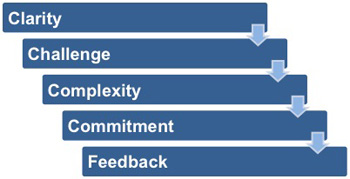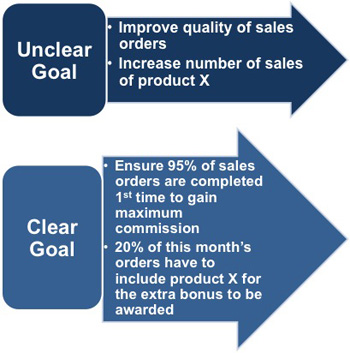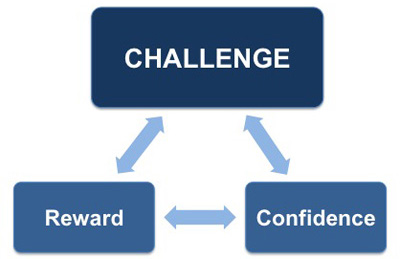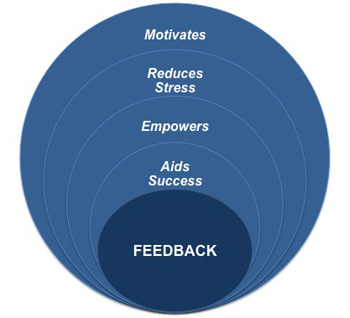The 4CF Method of Goal Setting
The work of Dr Edwin Locke and Dr Gary Latham in the 1960s stated that there are five fundamental principles for setting effective goals. (Locke, Edwin A., and Gary P. Latham. A theory of goal setting & task performance. Prentice-Hall, Inc, 1990.) They also said that the extent to which these principles existed within the goal related directly to the achievement of that goal.
Those principles are:
 |
If you choose to use this method to help set your goals then you will need to consider each principle in turn.
Clarity
To help understand what you wish to achieve at this stage it is useful to look at the definition of the word 'clarity':
'Clearness or lucidity as to perception or understanding; freedom from indistinctness or ambiguity.'
Your goal should state in a clear and concise way exactly what you want to achieve. There should be no room for ambiguity. It also needs to specify a finite period of time in which you can accomplish this goal.
By stating clearly what your goal is, you are motivated to fulfill it and can easily identify the reward you gain with its completion. There is no disillusion or disappointment, because you know exactly what is required. There can be no misunderstanding as your goal is easy to measure.
To demonstrate the importance of having a specific goal, below are some examples of goals that lack clarity, with an example of how to alter them to ensure they are clear and easy to understand.
 |
Challenge
Now that you have your clear goal it is important that your goal is also challenging. A challenge can be defined as:
'A call or summons to engage in any contest, as of skill, strength.'
The greater the reward we will gain on attaining our goal, the more we are motivated to do so. This motivation becomes larger the more the goal is perceived to be challenging, allowing a greater sense of accomplishment once you have fulfilled the goal.
 |
Whilst the goal needs to be 'challenging' it must be also be a goal that you have sufficient confidence that you can achieve. If the challenge is seen as too great, then there will be a negative effect on your willingness to work towards the goal, and in some cases you may not even try! Any reward offered needs to be appropriate for the task and exceed your normal expectations.
Setting a goal that has the right degree of challenge is an essential skill for ensuring all your team members are motivated. With the correct reward being offered to a member of staff on completion of a goal, other team members will also become motivated to gain this reward too.
For example, consider the following goal:
'Ensure 95% of sales orders are completed first time to gain maximum commission.'
This would be reasonably challenging if the current rate of orders completed were 75%, with the reason for most of the failures being incomplete data due to incorrect collecting and transcribing on the part of the sales person.
But, if instead the goal '20% of this month's orders must include product X for the extra bonus to be awarded' is set in an environment where product X normally accounts for 5% of all sales, then this goal could be seen as impossible. This goal would then have a negative effect on motivation rather than a positive one.
It could also reflect a poor understanding of product sales and the proportions of each in the overall sales figures. This illustrates the importance of having sufficient knowledge of the subject area when setting your own and others' goals.
Complexity
One definition of the word complex is:
'Complex - composed of many interconnected parts.'
A goal can comprise any number of interconnected parts as long as they form a coherent whole, which can be sensibly viewed as a single unit in its broadest terms.
The problem comes when a goal is too complex and the team member becomes confused about how best to achieve the goal. These feelings then result in poor motivation and often people resist and can even obstruct attaining the goal. The greater the degree of stress that results because of these feelings, the less likely it is that the individual will fulfill their goal.
This increased complexity can often be a result of unforeseen circumstances that come to light whilst working to achieve the goal. To avoid these problems, communication between the person who set the original goal and the one who needs to attain the goal is essential. This is especially true in more technical roles.
For example, this could be true of the goal '20% of this month's orders have to include product X for the extra bonus to be awarded' where due to the technical nature of product X only 10% of all existing customers have systems capable of using it. This would make the goal unachievable.
Also, if the price of this product requires a board-level decision in 80% of sales, then this means that four weeks is an unrealistic timescale. This goal could be modified by saying '… this quarter's orders ...' which would allow adequate time for a purchase of product X to be agreed at the appropriate level.
Commitment
Before anyone commits himself or herself to a goal they will probably want to see evidence that there are sufficient resources available. Without these resources they will not be able to achieve the desired goal and this is an essential element in gaining commitment.
The most productive way in which to obtain commitment to a goal is to actively involve the team member in the goal-setting process. By sharing your knowledge during this process the goal is likely to be clearer, be sufficiently challenging, and have an appropriate level of complexity.
One of the most effective ways management gain commitment from their staff is through the annual appraisal system where goals are discussed and agreed. As part of this exercise, the goals set will adhere to established expectations and rewards that can be offered.
For example, if you are the new manager of the sales team and from your investigations you know that the quality of order-taking is poor due to lack of detail, you can decide to set a goal to 'Ensure 95% of sales orders are completed first time to gain maximum commission.' You can discuss this at your next team meeting and gain everyone's acceptance to commit to this goal.
Feedback
Once you have set a goal and delegated the task, it is vital that you not only monitor progress but also provide regular feedback to the team member. This is particularly important in the first few days because team members often feel uncomfortable asking for guidance once they have been delegated the task, assuming that it will reflect badly on them if they don't just 'get on with it.'
This can cause unnecessary anxiety if, as is often the case, they are unsure how exactly to proceed once they examine the task in detail. This usually happens when it becomes clear that there are several options available or when they become aware of an unforeseen problem.
Team members must have the opportunity to give you regular updates on their progress and have the chance to inform you of any unplanned obstacles that may have arisen, which need to be addressed.
The trick is to ask for and provide feedback without being viewed as interfering unnecessarily or showing any impatience if the team member is confused by something that you think should be clear. It is also important that feedback is given while there is still time to act upon it.
 |
Feedback is a major contributor to motivation and empowers people by enabling them to build upon their successes; it also allows them to know that their efforts are appreciated. This should improve their performance and enable them to keep their problems and concerns in perspective.
For example, if the goal you have set is to 'Ensure 95% of sales orders are completed the first time to gain maximum commission,' one of the causes for sales orders not being completed first time could be, hypothetically, that the IT system has insufficient lines in the address field to allow for customer's complete details to be entered, resulting in orders being returned.
Without resolving the limitations of the IT system your team can never achieve the goal and this issue may never have come to light without feedback.
As well as the 4CF Method, you should also be aware of the SMART Method. Each method has both advantages and disadvantages on its own, and so it is therefore important to use these two methods together, as it is entirely possible that using one method on its own will produce a goal that is deficient in some way. There is also the additional benefit that you can produce a 'goal statement' that best suits your circumstances and the culture of your organization.
You may also be interested in:
Goal Setting for Managers | Goal Setting Theories of Locke and Latham | SMART Goal Setting for Managers | Backwards Goal Setting | Prioritizing Personal Goals.



